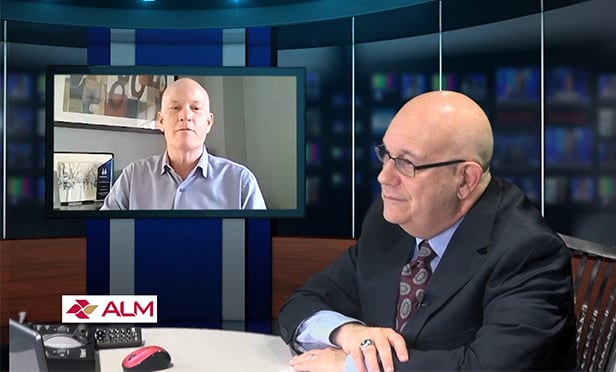(Building operations and management your passion? Watch for Better Buildings, a new supplement to Real Estate Forum, launching in our February/March issue.)
NEW YORK CITY-Aging infrastructure, climate change, vanishing public space and transportation challenges are all issues facing the built environment – and for the New York Chapter of the American Institute of Architects, the future of the commercial real estate industry is now.
“The focus, I think, is the fact that the majority of our building stock is well over 50 years old in Manhattan alone,” says Joseph J. Aliotta, AIA New York chapter president and US COO/principal at Swanke Hayden Connell Architects, in a sit-down interview with GlobeSt.com at Swanke’s headquarters inside the Puck Building.
In asking what Manhattan’s vertical landscape will look like over the next 20 to 50 years, Aliotta—AIA’s 2012 chapter president—came up with the theme “Future Now” as a way for real estate professionals, building managers, architects, engineers and designers to address the city’s biggest challenges. A team of five different AIA subcommittees will be evaluating energy and the environment; infrastructure and transportation; water and the waterfront; public spaces; and housing, education and public health.
Using the Empire State Building as the ‘poster child,’ Aliotta says many older buildings like it will be repositioned in order to stay up-to-date and reduce energy output.
“Here’s a building that is obviously iconic in New York City that became somewhat obsolete for office space,” he says. “It was dentists, doctors and lawyers, and it really wasn’t the type of office space that tenants were looking for,” he explains. After a $550 million repositioning and achieving LEED Gold status by the United States Green Building Council, the building’s ownership—the Malkin family—developed a groundbreaking initiative and model working with the Clinton Climate Initiative and Rocky Mountain Institute for energy efficiency and retrofits for occupied commercial office buildings.
“They basically made it extremely more energy-efficient and they improved the building immensely,” he says. “They’ve now gained different tenants.”
The retrofitting of older buildings also ties in with city policy. As a compliment to the city’s 30-year visioning plan, plaNYC, the New York City Department of City Planning has launched “Zone Green,” an initiative which aims to improve over one million buildings with energy efficient features, which cost $15 billion per year to power and heat, and account for 80% of the city’s greenhouse gas emissions.
“In New York City because it is sustainable in the sense that we are so dense, but on the other hand, the buildings account for about 85% of energy use,” says Margaret O'Donoghue Castillo, principal at Helpern Architects, PC and the 2011 chapter president of AIA NY. “If you tackle the buildings, their initiative to tackle existing buildings is very appropriate.”
Since February 2010, both Mayor Michael Bloomberg and City Council Speaker Christine Quinn convened the city’s Green Codes Task Force to examine how to mitigate the impact of green building construction and renovation. At this point, 29 of the council’s 111 ‘green’ recommendations have been adopted and incorporated into the city’s building code and laws – and eight more are currently in the pipeline.
Castillo says "if you put the money and invest in better buildings that actually will cover the life of the building," there is a less likely chance they will be razed. “We are constantly doing adaptive re-use, because it also has embodied the energy – it took a lot of energy to make the building,” she says.
In addition to AIA’s five subcommittees, a new area of focus—risk & recovery—will also focus on storm preparedness, natural disasters and emergency planning. At a panel called “Rising Tides 2080” earlier this year, Aliotta says the panelists and attendees addressed temperature changes and how it effects the five boroughs.
“In theory, if global warming continues, and we had a professor from Columbia who was researching all this, a good portion of our waterfront will be underwater,” he said. “And that certainly is something that needs to be discussed. These are all very real and serious things. The idea this committee is looking at ways to explore these issues and find a way to mitigate it.”
Another focus, he says, is engaging young professionals in civic life.
“It’s about mentorship,” he says. “2080 is a long time from now, but looking at the future of the city and looking at all these issues, this is what we need to do."
Want to continue reading?
Become a Free ALM Digital Reader.
Once you are an ALM Digital Member, you’ll receive:
- Breaking commercial real estate news and analysis, on-site and via our newsletters and custom alerts
- Educational webcasts, white papers, and ebooks from industry thought leaders
- Critical coverage of the property casualty insurance and financial advisory markets on our other ALM sites, PropertyCasualty360 and ThinkAdvisor
Already have an account? Sign In Now
*May exclude premium content© 2024 ALM Global, LLC, All Rights Reserved. Request academic re-use from www.copyright.com. All other uses, submit a request to [email protected]. For more information visit Asset & Logo Licensing.








